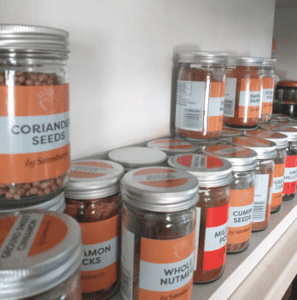In this month’s blog we explore how to make the most of store cupboard ingredients and take a look at how to reduce food waste.
How to reduce Food Waste
Start by reviewing your store cupboard ingredients and check which food items are in- date. We like to take a ‘shelfie’ every now and again, which helps us to avoid buying items that we have enough of at home. When it comes to reviewing dates on food items what should we be looking at?
The Use-by Date
The use-by date is about food safety and therefore the most important date to look at.
According to the Food Standards Agency, foods can be eaten until the use- by- date, but not after.
You will see use- by dates on food that goes off quickly, such as meat, dairy products or ready-to-eat salads.
For the use- by date to be a valid guide, you must carefully follow storage instructions. For example, if the instructions on the packaging tell you to refrigerate after opening, you should keep the food in a fridge at 5°C or below.
The Best- Before Date
The best- before date (sometime shown as BBE – best before end), is about quality and not safety.
The food will be safe to eat after this date, but may not be at its best. Its flavour and texture might not be as good.
Best- before dates appear on a wide range of foods including frozen foods, dried and tinned foods.
The best- before date will only be accurate if the food is stored according to the instructions on the packaging.

How to reduce food waste – storing safely and make it last longer
There are a number of foods that need to be kept in the fridge to help slow down germs’ growth and keep food fresh and safe for longer. These are foods marked with a “use by” date and “keep refrigerated” on the label, such as milk, meat and ready meals.
- If you are keeping any leftover food, cool it down as quickly as possible (within 2 hours), store in the fridge and eat within 2 days.
- Avoid putting open tin cans in the fridge, as the food inside may develop a metallic taste. Follow the manufacturer’s instructions or place the contents in a storage container or covered bowl before refrigerating.
- Keep your fridge temperature at 5C or below.
- Top tip Keep your fruit and vegetables in the fridge as it will last longer (apart from potatoes, onions, bananas and pineapple).
- Keep bagged salad and spinach leaves fresher by putting a piece of kitchen towel in the bag – it will stop the leaves going slimy.
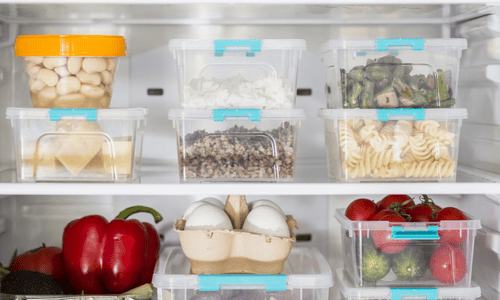
Freezing Food
- You can freeze pretty much everything by placing the food in an airtight container or wrapping it tightly in freezer bags, before placing in the freezer, otherwise the cold air will dry it out.
- Label the food with the name and date it was frozen.
- When defrosting food, plan ahead so you leave enough time and space to defrost small amounts of food in the fridge. Food should be thoroughly defrosted before cooking (unless the manufacturer’s instructions tell you to cook from frozen).
- If you cannot defrost food in the fridge, you could put it in a container and then place it under cold running water. Raw meat and poultry (including large joints and whole birds), should not be defrosted under cold running water unless they are in a sealed container.
- You can also defrost food in the microwave on the ‘defrost’ setting. If necessary you could defrost food at room temperature. Follow the manufacturer’s defrosting instructions.
- Food should be left out at room temperature for the shortest time possible. Ideally, it is bet to defrost foods in the fridge.
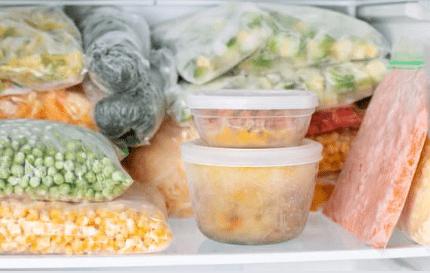
Useful links
- NHS choices (opens in new tab) has lots of useful information on how to safely freeze different foods
- You can find fantastic advice from Love Food Hate Waste (opens in new tab) on how to store household items correctly
How to reduce food waste – food choices
A healthy diet means eating a wide variety of foods in the right proportions, and consuming the right amount of food and drink to achieve and maintain a healthy body weight. Where you can, try to stick to a mealtime routine when you are working from home and at the weekends.
The Eatwell Guide provides lots of guidance on how to achieve a balanced diet across the week by:
- Aiming for 5 portions of a variety of fruit and vegetables every day
- Base meals on starchy foods like potato, bread, rice or pasta
- Have some dairy or dairy alternatives across the day
- Include beans, pulses, fish, eggs, meat and other protein twice per day (three times if you are vegetarian)
- Choose unsaturated oils and spreads, include sparingly
- Drink plenty of water, at least 6 to 8 drinks across the day.
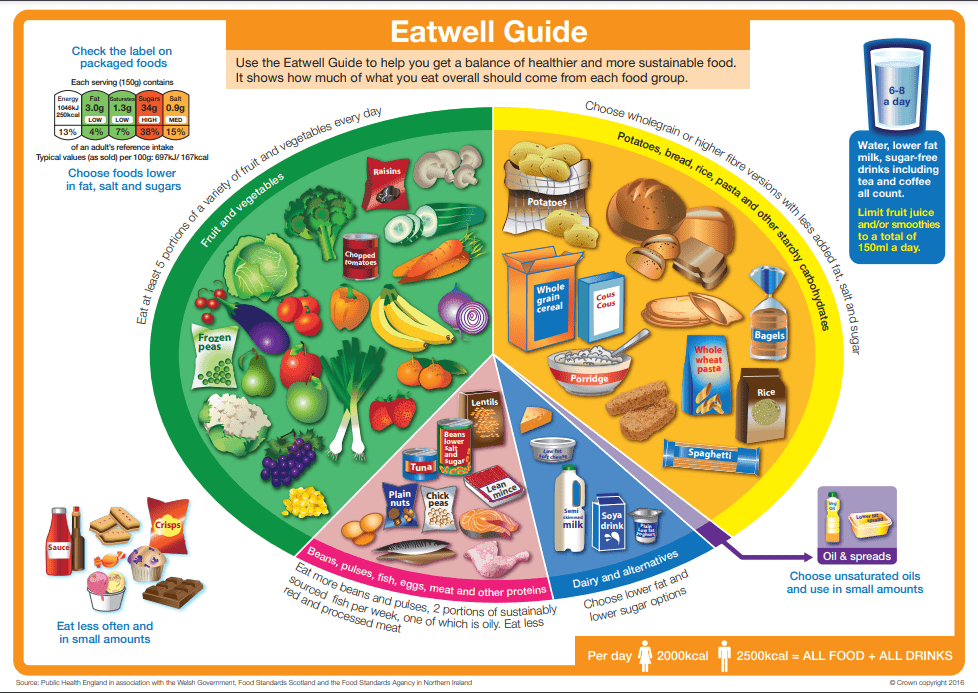
Let have a look at some handy store cupboard ingredients and how you can use them in day to day recipes.
Fruit and vegetables:
Aim for 5 portions of fruit and vegetables every day. You can count the following:
- Tinned tomatoes: Use these to create rich pasta sauces and use in dishes such as Bolognese and chilli. Here is one of our favourite recipes using tinned tomatoes: Chilli Jacket Potato (opens in new tab)
- Dried fruit: Dried fruits, such as sultanas, apricots, figs and dates, are useful for adding sweetness to breakfasts, natural yoghurt and desserts. While dried fruit won’t have the vitamin C that fresh fruit does, dried fruit still contributes to your five a day and can also be a source of nutrients like fibre and iron. Please note- only offer to children when added to cereal or pudding and not on its own, to reduce the risk of tooth decay. Here is one of our favourite recipes using dried fruit: Hot Cross Buns(opens in new tab)
- Tinned fruit and vegetables: Tinned fruit keeps for ages and will count towards your five- a- day. During the winter it can be a good way of getting more exotic, out of season fruits into your diet, like peaches and pineapple. Just make sure the fruit is tinned in fruit juice rather than syrup, and that vegetables are tinned in water, without added salt or sugar. Here is one of our favourite recipes using tinned fruit/vegetables: Apple and Pear Porridge (opens in new tab)
- Frozen fruit and vegetables: Frozen vegetables are much cheaper than fresh vegetables, and because a lot of them are frozen within a couple of hours of being picked, most of the time they’re going to be fresher. There is also less preparation time so they’re perfect to use in your evening meals. Here is one of our favourite recipes using frozen vegetables: Mac and vegetable slice (opens in new tab).
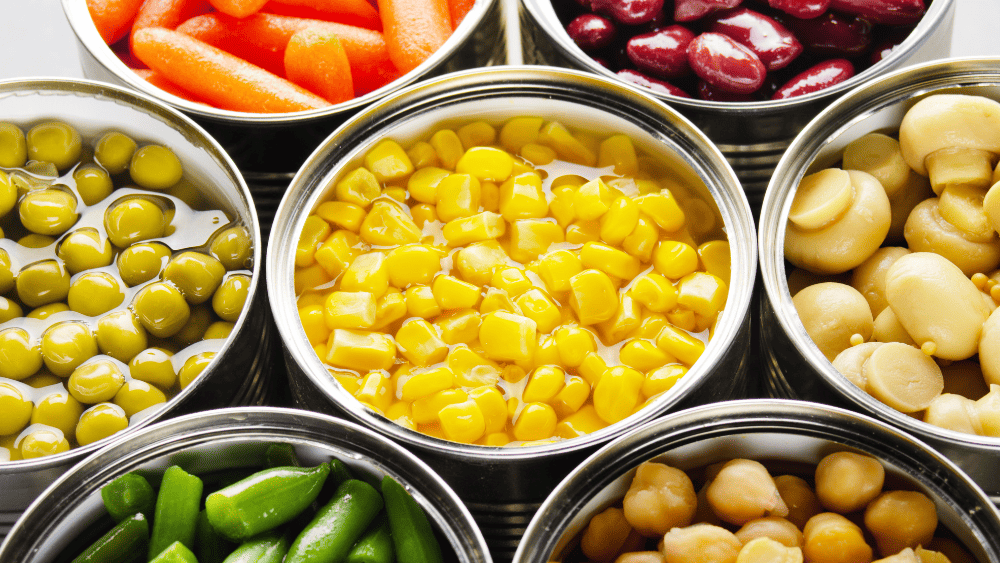
Beans, pulses, fish, eggs, meat and other protein
Include beans, pulses, fish, eggs, meat and other protein twice per day (three times if you are vegetarian). You can count the following:
- Tinned fish in water: Tuna is perfect as a sandwich filling, to top a salad or jacket potato or for more substantial meals, like a tuna bake or in a tomato based pasta sauce. Try sardines on toast or with pasta. Anchovies add fantastic depth of flavour to sauces. Here is one of our favourite recipes using tinned fish: Salmon and cucumber wrap (opens in new tab)
- Tinned lentils, pulses: Pulses are a good ingredient to bulk out meat dishes, alongside being a great vegetarian source of protein. Dried pulses keep well too, but when they are tinned in water they are ready- to- eat, making them a quick and easy choice. Chickpeas or lentils for example, can be mixed with salads and pasta dishes, or used in soups and stews. They can also be used for making homemade hummus. Here is one of our favourite recipes using tinned pulses: Moroccan Vegetable and chickpea tagine
- Peanut butter: That jar of peanut butter in your cupboard is useful for more than just toast in the morning! You can also add to overnight oats, as a rice cake topping or in stews and curries.
- Meat, Poultry: These ingredients can easily be frozen and used as required. Use mince for cottage pie, stewing cuts for one-pots, like beef stroganoff and fillets, or sirloins for a Sunday roast. Serve whole chicken breasts breaded, stuffed or cut into chunks in tasty stews, curries, salads and sides. Here is one of our favourite recipes using chicken: Sweet and sour chicken (opens in new tab)
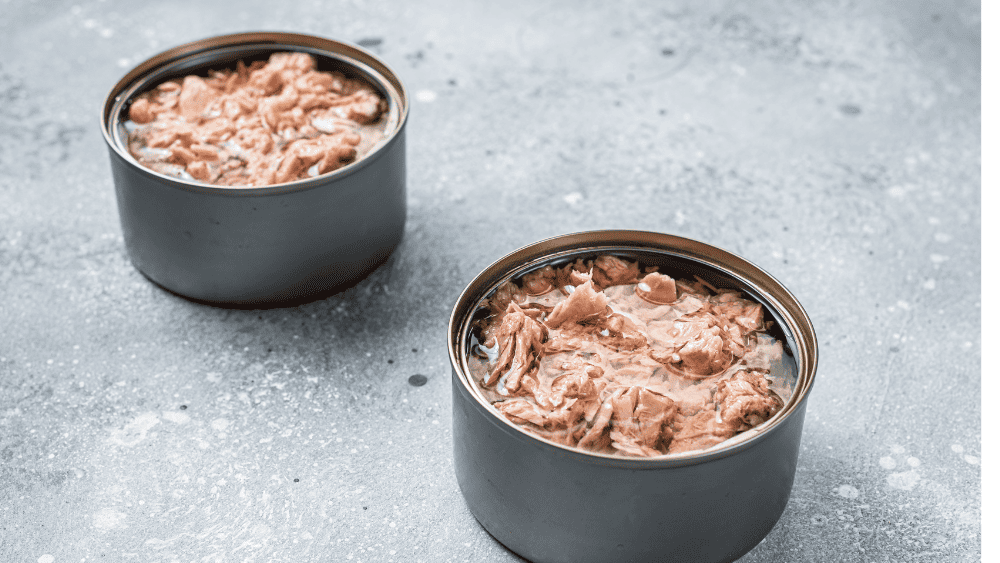
Starchy Foods
Base meals on starchy foods like potato, bread, rice or pasta:
- Pasta, rice, cous cous: Pasta can be used as a starchy accompaniment for main meals, as well as having it cold in pasta salads. Couscous is very easy to cook: a bit of measuring and then simply soak it in boiling water. Serve it in salads, or with stews and grilled meat. Pearl barley has little flavour, so can be used in soups and stews as a thickener. Try it as a low-cost alternative to risotto rice. Here is one of our favourite pasta recipes: Pasta Carbonara (opens in new tab)
- Flour: A bag of plain flour can be useful for making pancakes and scones, as well as to thicken a white sauce or casserole. Great for padding out, lining and thickening dishes. It can be used to make bread and sauces. Here is one of our favourite recipes using this ingredient: Easy Bread (opens in new tab)
- Bread, pitta, bagels, wraps: Bread, pitta and wraps are prefect for breakfast, lunch and snack recipes. These items are also easy to freeze and can be defrosted as and when you need them. They are so versatile and there are lots of great toppings you can use to add flavour. Here is one of our favourite recipes using these ingredients: Salmon and courgette bagel (opens in new tab)
- Oats: Oats are a good store-cupboard ingredient for sweet dishes. Use them to make flapjacks, in crumble toppings, or add them to cookies and muffins. Keep a big bag of oats in the cupboard ready for any number of breakfast options. Make your own healthy take on a crunchy granola, soak in milk and yogurt for easy overnight oats ready to be topped with fresh fruits in the morning. Here is one of our favourite porridge recipes: Three bears breakfast (opens in new tab)
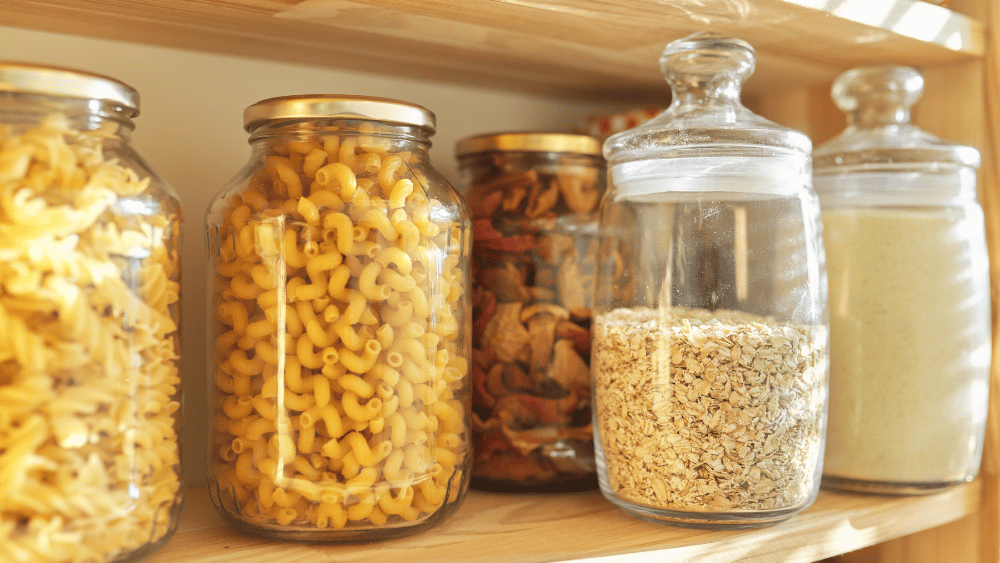
Dairy and alternatives
Have some dairy or dairy alternatives each day including the following:
- Milk: Fresh or long- life milk are great options. You can also freeze milk and thaw in the fridge overnight, when required
- Cheese: Some hard cheeses, like Cheddar, can last more than two weeks, as long as you make sure to store them properly. Shredded cheese can last even longer when frozen. Grate your cheese and then freeze it – you can just grab a handful whenever you want a topping for pasta, pizza, and shepherd’s pie… whatever you like! Have a go at making the following Pizza (opens in new tab)
- Yoghurt: Plain or natural yoghurt are good healthy options. Try making your own tzatziki with low-fat yogurt, grated cucumber, minced garlic, fresh lemon juice, fresh mint, dill and chives, and black pepper. We love this Tazatziki recipe (opens in new tab)
- Custard: Use reduced-fat milks to make custard and milk puddings. Why not try this delicious Banana Custard (opens in new tab) recipe.

Top tip for planning meals
- Write a meal plan for the week and only buy what you need.
- Get into the habit of checking what you already have in the fridge and freezer before you go shopping.
- Look out for foods that are approaching their use-by date and other fresh foods, that can go off over time, and try to use them up first. This includes: meat and fish, cheese, milk or other dairy products
- Use your leftovers for meals the following day, or freeze them for future meals.
- Food doesn’t need to be frozen on the day of purchase and is fine to freeze up to the use-by date.
- Grow something that you can use in the kitchen, such as herbs, tomatoes and sprouts. If you’re a novice gardener, growing an indoor culinary herb garden (opens in new tab) is an easy place to start. All you need to get started is a nice, sunny place in your house for them to call home.
You can find more great tips in our blog ‘Feed Your Family On A Budget (opens in new tab)‘!
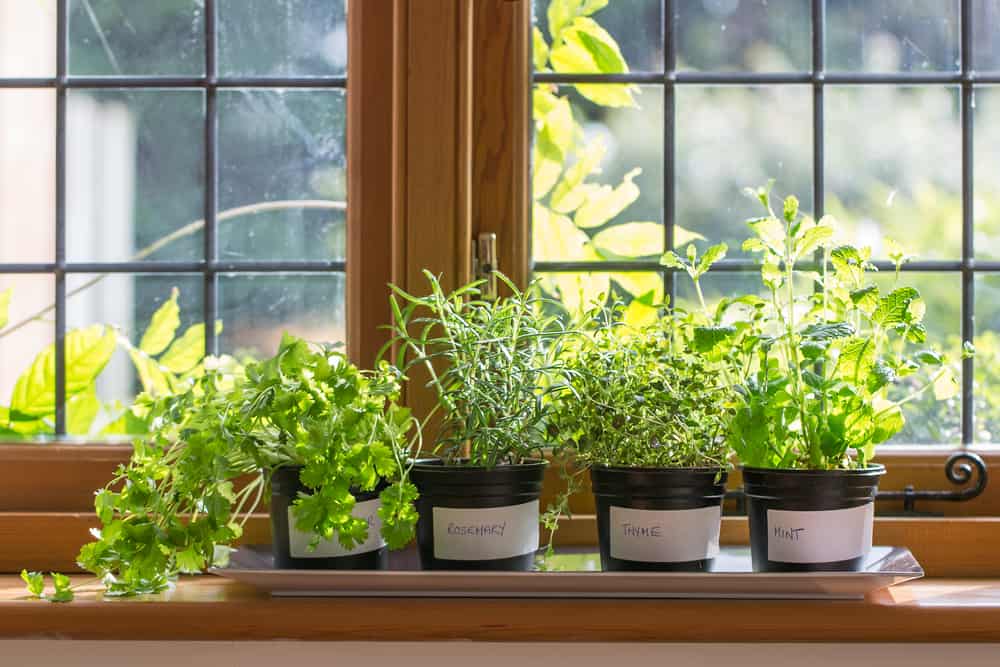
Food Banks
Food bank supplies are running low. If you can, consider donating food items, toiletries and baby items, to ensure people in your local community stays stocked. Visit the following websites for more information on how you can help.

